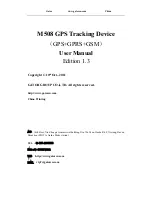
Watson Industries, Inc.
DMS-SGP01 Rev B 03/22/2018
5
Operation
Initialization
Ideally, the DMS should be stationary and level when it is turned on. If not, the sensor readings
may not be accurate after initialization. The time required for the initialization process is not the
same for every type of DMS, but typically takes 4 to 5 seconds. During this time, a message is sent
from the unit via the RS-232 serial link. This message gives information about the DMS such as
the full model number, serial number, and software revision. The message can be read by using a
terminal program or by using the terminal mode of Watson Industries’ communication software.
The DMS can also be “re-initialized” after it has been turned on. This is especially useful if the
sensor has been used in severe maneuvers that have over-ranged the angular rate sensors and
caused significant errors to accumulate. Sometimes re-initializing the unit will allow for a faster
recovery than waiting for the error correction routines to correct the sensor readings. There are
several ways to re-initialize the DMS. For more information, see the Interface section of this
manual.
Normal Operation
During normal operation, the DMS will output highly accurate inertial data for the user to interpret.
This data is transmitted in several different ways. The most common way to acquire data from the
DMS is to use the RS-232 serial output. There are two RS-232 output formats: decimal and binary.
The exact formatting structure is discussed later in the Interface section of this manual. The DMS
generates fourteen different data items for output: X, Y, and Z rates, X, Y, and Z accelerations,
Bank, Elevation, and Heading, and Forward, Lateral, and Vertical Accelerations, Velocity, Latitude
& Longitude. Any combination of these data items can be selected for transmission via the RS-232
serial link. The DMS also has analog outputs (see Interface section) that can be used to send data to
the user.
In normal operation, the DMS takes data from its internal rate sensors and integrates in a closed
loop system, with the accelerometers as a long-term reference, to generate Bank, Elevation and
Heading data. In most cases, these algorithms provide for very stable and accurate output signals;
however, the user should be aware that exceeding the normal ranges of the sensors would affect
accuracy. For example, while custom DMS units may have differing ranges, the rate sensors in a
typical DMS have a maximum rate of 100
°
/s. Care should be taken not to exceed this rate because
the closed loop system will receive inaccurate data. This will result in errors in the angle output
signals.
While this DMS is "all attitude", the accuracy deteriorates rapidly when its forward direction is
within about 5 degrees of vertical. Operation for any extended period of time at more than 60
degrees from level is not recommended. If these few operational precautions are observed, the
DMS should provide very accurate data for a wide variety of applications.
Special Operation Modes
Reference Mode
This mode is usually used for calibration or diagnostics. When in reference mode, the DMS will
output data generated directly from the sensor reference signals rather than as a product of the
closed loop integration used for normal operation. This mode provides sensor information similar
to normal operation mode with the following differences:
Bank and Elevation are obtained directly from the accelerometers - no gyro stabilization.






































